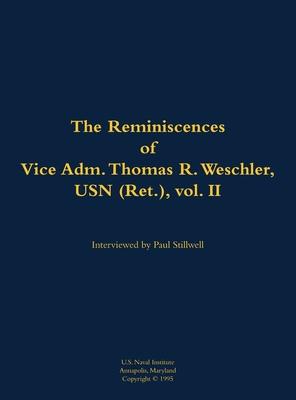Weschler was not commissioned at the time of his graduation from the U.S. Naval Academy in 1939 because he did not meet the vision standards. Thus he became a merchant marine officer and served until joining the Naval Reserve in 1941 and being recalled to active duty. He taught briefly at the Naval Academy, then served in the carrier USS Wasp (CV-7) and was on board when she was torpedoed and sunk in September 1942. Later he was in combat operations in the destroyers USS Sigsbee (DD-502) and USS Young (DD-580). Weschler took a postgraduate course in ordnance engineering, including study with Dr. Stark Draper at MIT. He was then gunnery officer in the heavy cruiser USS Macon (CA-132) and on the staff of Commander Cruisers Atlantic Fleet. After duty at the Naval War College, Weschler commanded the destroyer USS Clarence K. Bronson (DD-668). He was selected as the first personal aide for Admiral Arleigh Burke, who became Chief of Naval Operations in 1955. Weschler’s oral history provides fascinating insights into Burke’s personality and working style. Afterward, Weschler was executive officer of the guided missile cruiser USS Canberra (CAG-2) and then worked on the development of the Polaris missile guidance and fire-control system. For several years, beginning in 1962, Weschler was involved in various aspects of the developing war in Southeast Asia. As a student at the National War College, he studies South Vietnam and made a visit there as part of a class field trip. Then he commanded the attack transport USS Montrose (APA-212) during Pacific Fleet exercises. On the staff of Commander Amphibious Force Pacific Fleet, he participated in large-scale exercises, then helped do the planning for the 1965 landing at Danang. As Commander Amphibious Ready Group Seventh Fleet, he executed Dagger Thrust raids in Vietnam, then in 1966, upon selection for rear admiral, became the first flag officer as Commander Naval Support Activity Danang. In 1967 he became program coordinator for the DX/DXG program that led eventually to the Spruance-class destroyers and Virginia-class frigates. Later tours of duty were as Commander Cruiser-Destroyer Flotilla Two and Commander Cruiser-Destroyer Force Atlantic Fleet. Finally, as a vice admiral, Weschler headed J-4, the logistics branch of the Joint Staff, during the 1973 Yom Kippur War and Arab oil embargo. Following retirement in 1975, he taught at the Naval War College.
| FindBook |
有 1 項符合
Reminiscences of Vice Adm. Thomas R. Weschler, USN (Ret.), vol. II的圖書 |
 |
Reminiscences of Vice Adm. Thomas R. Weschler, USN (Ret.), vol. II 作者:Weschler 出版社:US Naval Institute Press 出版日期:2017-04-28 語言:英文 規格:精裝 / 404頁 / 27.94 x 21.59 x 2.39 cm / 普通級/ 初版 |
| 圖書館借閱 |
| 國家圖書館 | 全國圖書書目資訊網 | 國立公共資訊圖書館 | 電子書服務平台 | MetaCat 跨館整合查詢 |
| 臺北市立圖書館 | 新北市立圖書館 | 基隆市公共圖書館 | 桃園市立圖書館 | 新竹縣公共圖書館 |
| 苗栗縣立圖書館 | 臺中市立圖書館 | 彰化縣公共圖書館 | 南投縣文化局 | 雲林縣公共圖書館 |
| 嘉義縣圖書館 | 臺南市立圖書館 | 高雄市立圖書館 | 屏東縣公共圖書館 | 宜蘭縣公共圖書館 |
| 花蓮縣文化局 | 臺東縣文化處 |
|
|
圖書介紹 - 資料來源:博客來 評分:
圖書名稱:Reminiscences of Vice Adm. Thomas R. Weschler, USN (Ret.), vol. II
|











